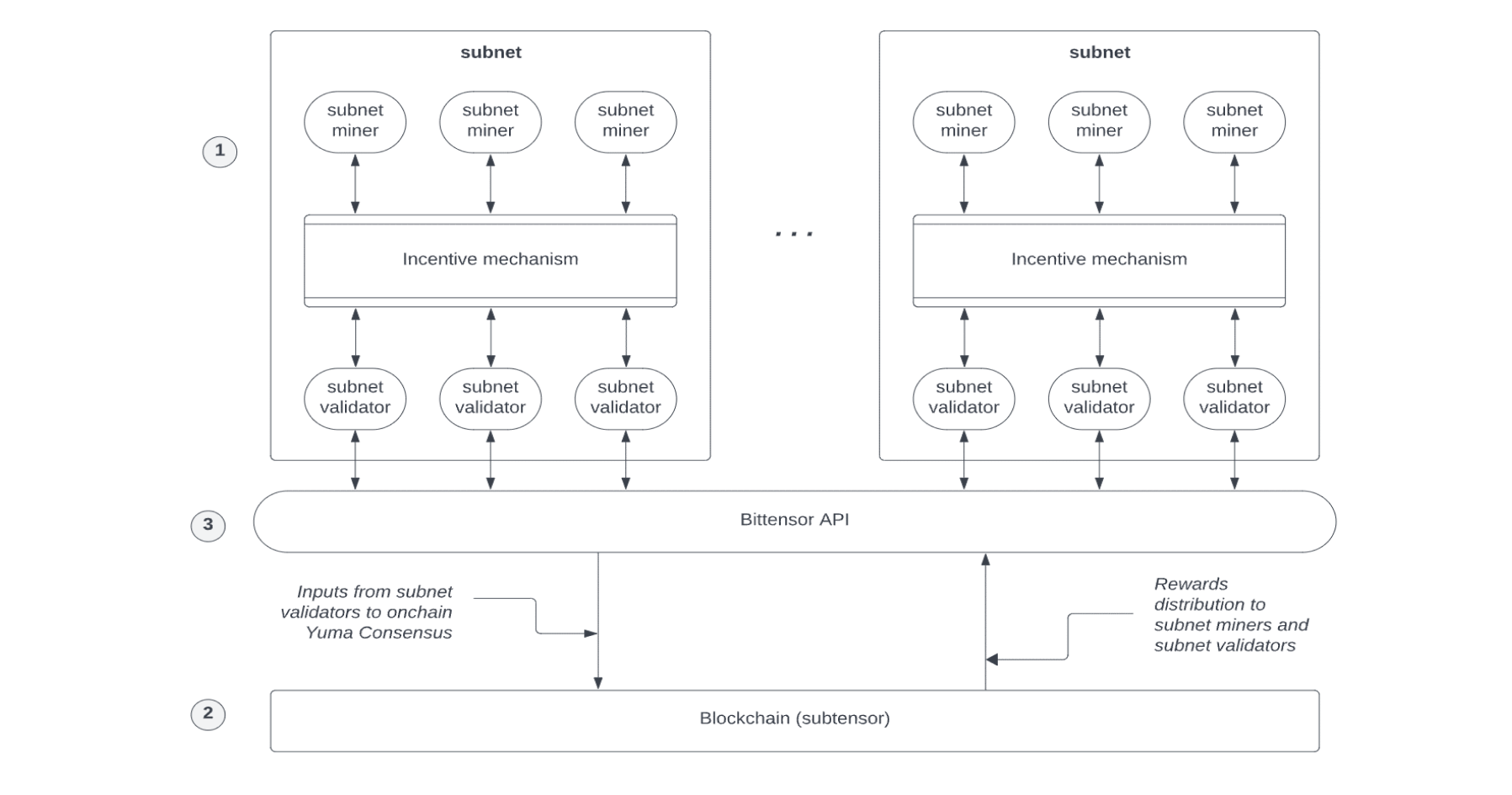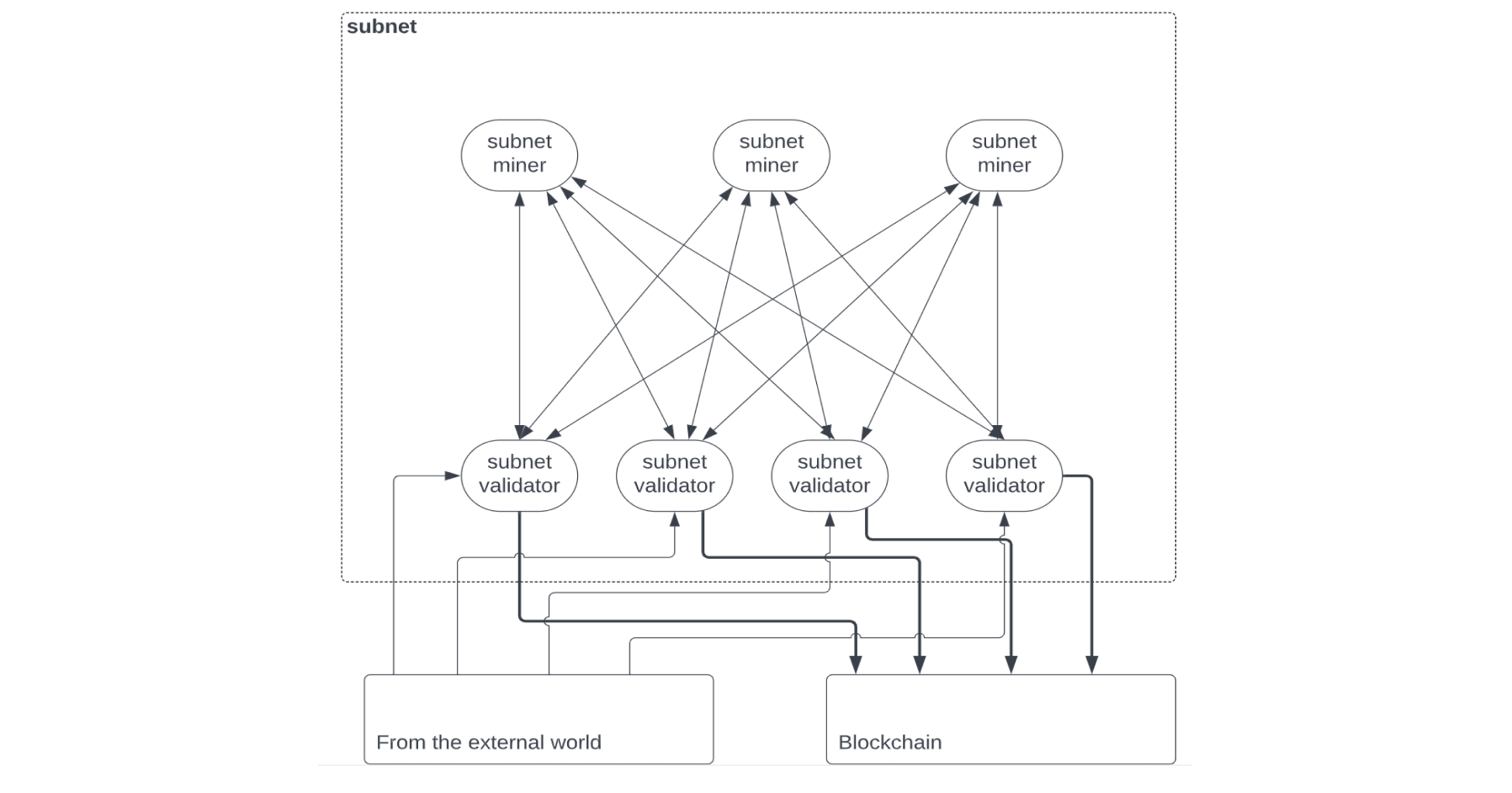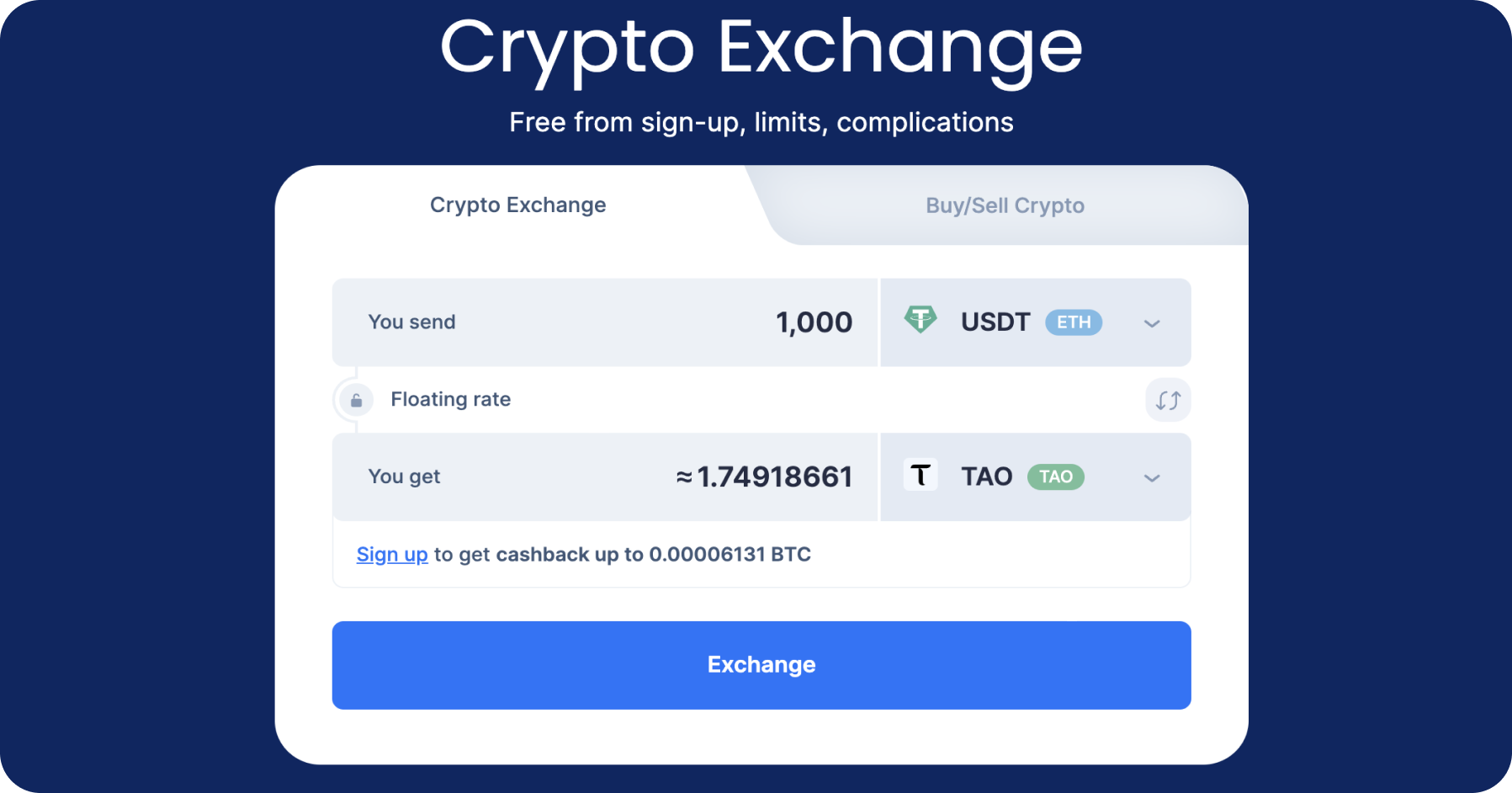Bittensor Ecosystem Overview

Key Insights
- Subtensor, the core blockchain of Bittensor, coordinates subnet activities, while Proof of Intelligence rewards nodes that perform machine learning tasks efficiently.
- The Bittensor network operates through subnets solving different AI tasks using a collaborative model approach.
- TAO tokens are central to Bittensor’s economy, providing rewards, governance, and transaction services, with future deflationary measures like halving.
What is Bittensor
Bittensor is a decentralized blockchain network designed for creating, training, and sharing AI and machine learning models.
It merges blockchain and AI technology, fostering a decentralized environment for advanced neural network solutions.
Bittensor aims to build a peer-to-peer marketplace where anyone can develop, train, and use high-quality AI models.
Subtensor: The Bittensor Core Blockchain
At the heart of Bittensor is Subtensor, the primary blockchain that coordinates activities across various subnets. These subnets perform specialized tasks, and Subtensor records their operations in its ledger.
Additionally, Subtensor determines the rewards for each subnet based on performance. Transaction validation in Subtensor is handled by validators of Opentensor Foundation using a Proof of Authority consensus mechanism.
Proof of Intelligence in Bittensor
Proof of Intelligence (PoI) is a consensus mechanism that rewards nodes for creating efficient AI and machine learning models. PoI combines elements of Proof of Stake and Proof of Work.
However, unlike Proof of Work, where nodes solve complex mathematical problems, Bittensor nodes perform machine learning tasks. The more accurate the node’s AI model, the greater the chance to add a new block to the blockchain and earn TAO tokens.
Bittensor Subnets
Subnets are critical components of Bittensor, each solving different AI-related tasks. For example, Bittensor Subnet 1 focuses on generating text responses, Bittensor Subnet 2 works on machine translation, and Bittensor Subnet 3 generates images.
These subnets employ the Decentralized Mixture of Experts (MoE) model, which allows collaborative model usage to tackle complex problems. Multiple models specialize in specific tasks, but they can merge when new data is available, creating synergy for more accurate and comprehensive solutions. Currently, there are 49 active subnetswithin Bittensor.
Information from subnets is relayed to Subtensor and stored in its ledger. Communication between subnets and Subtensor occurs through the Bittensor API.

Bittensor Work Sheme. Source: Bittensor
Key Bittensor Subnet Participants
The operation of Bittensor subnets relies on several key participants:
- Miners
Miners in the Bittensor ecosystem offer their AI models and computational power to solve specific tasks within subnets, such as translation or image generation. They receive data from validators and complete tasks independently using their models, earning TAO tokens as rewards.
- Validators
Validators monitor the work of miners, assess the effectiveness of their AI models, and ensure optimal task executionwithin Bittensor subnets. They also process external data and report subnet activity back to Subtensor. Like miners, validators work independently and earn TAO token rewards.
- Users
Users participate in Bittensor subnets by posing questions and creating tasks, which are then assigned to subnets for solutions.

Scheme of Subnets Operation. Source: Bittensor
Economic Model of Bittensor
Bittensor’s economic model revolves around the TAO token, which is minted every 12 seconds and distributed across active Bittensor subnets to reward participants. The allocation of TAO in subnets is as follows:
- 18% to the subnet owner
- 41% to subnet validators (dividends)
- 41% to subnet miners (incentives)
The reward size depends on the quality of work performed. For example, miners with better AI models receive higher TAO tokens rewards.
Staking and Delegated Staking in Bittensor
Participation in Bittensor requires staking TAO tokens. Staking involves locking tokens in a smart contract, which incentivizes participants to act honestly.
Misbehavior may lead to slashing, where the staked tokens are forfeited. Participants can also lose tokens for providing low-quality services. The larger the stake, the more trusted the participant is within the network.
Delegated staking is also available. Community members with TAO tokens can delegate their tokens to a validator within a Bittensor subnet for additional yield.
TAO Token
What is TAO crypto
The TAO token is the core element of Bittensor economy. It has a limited supply of 21 million tokens and follows a deflationary model. Similar to Bitcoin, TAO’s emission will decrease through halving events, with the first halving scheduled for November 2025.
Currently, the circulating supply is around 7.38 million tokens with a TAO market cap of $4.22 billion.
Key functions of TAO token include:
- Incentives
TAO is the main reward for validators and miners in the Bittensor ecosystem who perform tasks efficiently. It also serves as an economic incentive, as participants stake their tokens.
- Governance
TAO holders can propose and vote on protocol updates, decentralizing the decision-making process among stakeholders in the Bittensor network.
- Transaction Fees
TAO is used to pay for transactions within the Bittensor blockchain, such as token transfers or smart contract execution.
- Access to Services
TAO is the currency for purchasing services within the Bittensor marketplace, such as data analysis or model training.
Bittensor Future Prospects
Bittensor has promising potential to become a leading project integrating blockchain and AI technologies. The TAO token has seen substantial growth in recent weeks, with positive TAO price trends in 2024. Several key factorscontribute to the growth of TAO:
- Advancements in decentralized AI models
Bittensor plays a pivotal role in democratizing AI development, allowing collaborative solutions among participants.
- Development of subnets
The quality of AI models and services provided by Bittensor subnets continues to improve. Many Bittensor subnets are managed by professional teams that tackle complex machine learning tasks.
- Introduction of dynamic TAO (dTAO)
dTAO increases demand for both subnet and TAO tokens, positively affecting their market value.
- Smart contract integration
Bittensor plans to introduce EVM compatible smart contracts in the near future. This will significantly expand the capabilities of developers and subnet participants and make Bittensor compatible with Ethereum.
The integration of smart contracts will be a crucial step in establishing Bittensor as a leading Layer-1 AI blockchain.
You can buy TAO tokens quickly and with minimal fees on SimpleSwap.

Summary
Bittensor is poised to become a significant player at the intersection of AI and blockchain.
Its innovative use of decentralized AI models, coupled with the robust economic structure of TAO token, positions it for continued success.
With the upcoming integration of smart contracts and the introduction of dynamic TAO, Bittensor is well-positioned to lead in decentralized AI development.
The information in this article is not a piece of financial advice or any other advice of any kind. The reader should be aware of the risks involved in trading cryptocurrencies and make their own informed decisions. SimpleSwap is not responsible for any losses incurred due to such risks. For details, please see our Terms of Service.


